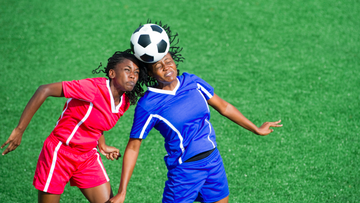The prospect of playing soccer in college is a dream come true for many young women. Of course, playing at this level opens doors to a special few who may get to play professionally. However, young women who will play at this level need to watch out for a sometimes overlooked facet of the game - injuries.
At the college level, the game becomes more aggressive and demanding, and the transition may not be smooth for all players leaving high school. This post will examine three injuries that college players face, and how players can prepare themselves.
3 Common Injuries that Affect Women in Soccer
Research shows that there are five areas where women suffer injuries the most in soccer, with two of them being the most prevalent. Those five regions include the head/neck, upper extremity, trunk/back, lower extremity, and other regions.
With that said, the three most common injuries occur in the head/neck and lower extremities. Roughly 70% of injuries take place in the lower extremity, while 13.8% of injuries affect the head and neck.
Keep in mind that the lower extremity accounts for two of the three injuries commonly seen in
female soccer players today.
Concussions (Head/Neck)
Head trauma and concussions are very common in women players, and sadly, underreported. Researchers have conducted numerous studies on men and have learned about the short-term and long-term effects of head impacts among them. Far less research has been done on women.
This is unusual because science has already identified women as having higher concussion risks than men, due to having less neck strength/muscle mass and thinner skulls. Nevertheless, concussions account for the third most common type of injury among women, making up 8.6% of reported injuries.
Knee Internal Derangements (Lower Extremity)
Knee injuries can have relentless effects on players and unfortunately, they’re all too common. Anything from hyperextended knees to sprains or contusions can occur. We’ve discussed before the Q-angle, which tends to be wider in women and contributes to a higher risk of leg injuries which includes knee damage. With that said, knee internal derangements account for 15.9% of injuries in soccer.
Ankle Ligament Sprains (Lower Extremity)
ACL ligament tears have probably given a good few soccer players nightmares. That infamous “pop” an ACL injury produces is just as frightening as the long recovery time to which it subjects a player.
Like knee derangements, the Q-angle makes women more susceptible to ACL sprains and tears. Unfortunately, ACL sprains are the most common injury to affect women at the college level, accounting for 18.3% of all injuries sustained during games.
Preventative Measures
Players, parents, and coaches need to recognize these injuries as credible threats to a player’s health and longevity. The reality is that many of the training regimens and play schedules at the college level only encourage some of these injuries.
Add to the fact that women’s college soccer has become more aggressive over the last few years, and the conditions can get rather dangerous. Fortunately, all of these injury risks can be reduced with the right steps.
Manage workloads
Overexertion takes the form of high volume, high-intensity scheduling. In other words, many games, practices, tournaments, and more can lead to fatigue that can either injure a player or make them susceptible to an injury. Coaches need to give players ample time to recover, and players themselves should advocate for this when necessary.
Concussion headband
Wearing soccer protective gear is an obvious way to reduce these injuries, but a less obvious piece of gear to wear is a concussion headband. A concussion headband may reduce the impact of head trauma, whether it’s sustained from a player-to-player or player-to-ball contact. Our ExoShield headguard has been shown to reduce impact forces by as much as 84%.
Leg guards
Wearing leg guards is a no-brainer, but you should make sure to invest in the highest-quality equipment possible. Also, consider wearing leg guards that offer more than the usual protection. For example, many of our Storelli leg guards feature impact protection that can help reduce collision forces sustained by the lower extremities.
Neuromuscular conditioning (FIFA 11+)
The highly-touted FIFA 11+ conditioning exercises have been praised for good reason. This series of exercises warms the body up at the neurological level, preparing the nervous system for vigorous and abrupt movements. FIFA 11+ prepares the muscles and joints so that they’re less likely to get injured, making lower extremity injuries less likely to occur.
Transitioning Into a College Player
Playing soccer at the college level is a huge opportunity and dream for many women. With that said, the expectations at this level are a lot higher, and the demands placed on players can push injury protection into the background. It’s vital for players to wear all necessary soccer protective gear and to make sure they’re shielded against these injuries as much as possible.
Also, players along with their coaches should pay attention to their training and conditioning, making sure they train appropriately without overload. Making these efforts will ensure that women can stay in good health and enjoy long careers on the pitch.
Need protective equipment for the lower and/or upper body? Browse through our line of women’s soccer protective gear to find your needs.

